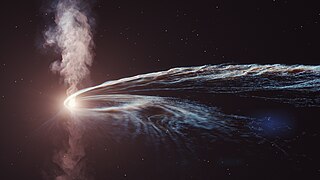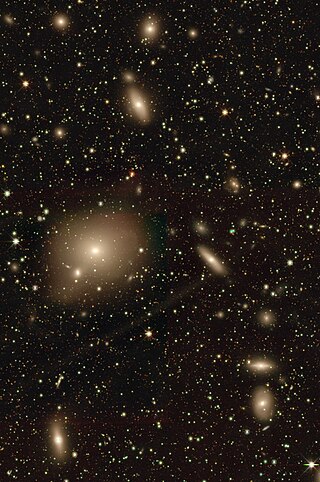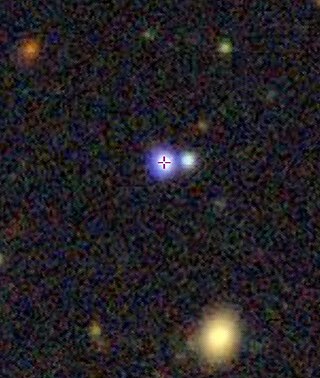Related Research Articles

The study of galaxy formation and evolution is concerned with the processes that formed a heterogeneous universe from a homogeneous beginning, the formation of the first galaxies, the way galaxies change over time, and the processes that have generated the variety of structures observed in nearby galaxies. Galaxy formation is hypothesized to occur from structure formation theories, as a result of tiny quantum fluctuations in the aftermath of the Big Bang. The simplest model in general agreement with observed phenomena is the Lambda-CDM model—that is, clustering and merging allows galaxies to accumulate mass, determining both their shape and structure. Hydrodynamics simulation, which simulates both baryons and dark matter, is widely used to study galaxy formation and evolution.

A radio galaxy is a galaxy with giant regions of radio emission extending well beyond its visible structure. These energetic radio lobes are powered by jets from its active galactic nucleus. They have luminosities up to 1039 W at radio wavelengths between 10 MHz and 100 GHz. The radio emission is due to the synchrotron process. The observed structure in radio emission is determined by the interaction between twin jets and the external medium, modified by the effects of relativistic beaming. The host galaxies are almost exclusively large elliptical galaxies. Radio-loud active galaxies can be detected at large distances, making them valuable tools for observational cosmology. Recently, much work has been done on the effects of these objects on the intergalactic medium, particularly in galaxy groups and clusters.

The Giant Metrewave Radio Telescope (GMRT), located near Narayangaon, Pune in India, is an array of thirty fully steerable parabolic radio telescopes of 45 metre diameter, observing at metre wavelengths. It is the largest and most sensitive radio telescope array in the world at low frequencies. It is operated by the National Centre for Radio Astrophysics (NCRA), a part of the Tata Institute of Fundamental Research, Mumbai. It was conceived and built under the direction of Govind Swarup during 1984 to 1996. It is an interferometric array with baselines of up to 25 kilometres (16 mi). It was recently upgraded with new receivers, after which it is also known as the upgraded Giant Metrewave Radio Telescope (uGMRT).

3C 305, also known as IC 1065, is a lenticular galaxy located in the constellation Draco. The galaxy is located 577 million light-years away from Earth. It has an active galactic nucleus and is classified as a Seyfert 2 galaxy. This galaxy was discovered by American astronomer Lewis Swift when he came upon it on April 7th, 1888.

Swift J164449.3+573451, initially referred to as GRB 110328A, and sometimes abbreviated to Sw J1644+57, was a tidal disruption event (TDE), the destruction of a star by a supermassive black hole. It was first detected by the Swift Gamma-Ray Burst Mission on March 28, 2011. The event occurred in the center of a small galaxy in the Draco constellation, about 3.8 billion light-years away. It was the first confirmed jetted tidal disruption event and is the most luminous and energetic TDE recorded.

Hercules A is a bright astronomical radio source in the constellation Hercules corresponding to the galaxy 3C 348.

A tidal disruption event (TDE) is a transient astronomical source produced when a star passes so close to a supermassive black hole (SMBH) that it is pulled apart by the black hole's tidal force. The star undergoes spaghettification, producing a tidal stream of material that loops around the black hole. Some portion of the stellar material is captured into orbit, forming an accretion disk around the black hole, which emits electromagnetic radiation. In a small fraction of TDEs, a relativistic jet is also produced. As the material in the disk is gradually consumed by the black hole, the TDE fades over several months or years.
Nadia Zakamska is a Russian-American astronomer who is a professor at Johns Hopkins University.
The KBC Void is an immense, comparatively empty region of space, named after astronomers Ryan Keenan, Amy Barger, and Lennox Cowie, who studied it in 2013. The existence of a local underdensity has been the subject of many pieces of literature and research articles.

NGC 4709 is an elliptical galaxy located in the constellation Centaurus. It is considered to be a member of the Centaurus Cluster and is the dominant member of a small group of galaxies known as "Cen 45" which is currently merging with the main Centaurus Cluster even though the two subclusters' line of sight redshift velocities differ by about 1500 km/s. NGC 4709 was discovered by astronomer James Dunlop on May 7, 1826.
Red nuggets is the nickname given to rare, unusually small galaxies packed with large amounts of red stars that were originally observed by Hubble Space Telescope in 2005 in the young universe. They are ancient remnants of the first massive galaxies. The environments of red nuggets are usually consistent with the general elliptical galaxy population. Most red nuggets have merged with other galaxies, but some managed to stay unscathed.

NGC 708 is an elliptical galaxy located 240 million light-years away in the constellation Andromeda and was discovered by astronomer William Herschel on September 21, 1786. It is classified as a cD galaxy and is the brightest member of Abell 262. NGC 708 is a weak FR I radio galaxy and is also classified as a type 2 Seyfert galaxy.

The Teacup galaxy, also known as the Teacup AGN or SDSS J1430+1339 is a low redshift type 2 quasar, showing an extended loop of ionized gas resembling a handle of a teacup, which was discovered by volunteers of the Galaxy Zoo project and labeled as a Voorwerpje.

In astronomy, a fast blue optical transient (FBOT), or more specifically, luminous fast blue optical transient (LFBOT), is an explosive transient event similar to supernovae and gamma-ray bursts with high optical luminosity, rapid evolution, and predominantly blue emission. The origins of such explosions are currently unclear, with events occurring at not more than 0.1% of the typical core-collapse supernova rate. This class of transients initially emerged from large sky surveys at cosmological distances, yet in recent years a small number have been discovered in the local Universe, most notably AT 2018cow.
AT2019qiz is a tidal disruption event (TDE) that occurred at a distance of 215 millions light years (65 megaparsec), from Earth. It is the nearest TDE discovered to date. It was discovered in September 2019 by observations in ultraviolet, optical, X-ray and radio wavelengths made at the European Southern Observatory (ESO) situated in Chile and was presented in October 2020 by research published in the monthly notices of the Royal Astronomical Society. It involves a star with a sun-like mass and a black hole with a mass of around 106 solar masses. The TDE appears very young and increasing in brightness. The encounter tore away half of the mass of the star and threw debris at a speed of 10,000 km/s, comparable to that observed in supernova explosions.

AT 2021lwx (also known as ZTF20abrbeie or "Scary Barbie") is the most energetic non-quasar optical transient astronomical event ever observed, with a peak luminosity of 7 × 1045 erg per second (erg s−1) and a total radiated energy between 9.7 × 1052 erg to 1.5 × 1053 erg over three years. Despite being lauded as the largest explosion ever, GRB 221009A was both more energetic and brighter. It was first identified in imagery obtained on 13 April 2021 by the Zwicky Transient Facility (ZTF) astronomical survey and is believed to be due to the accretion of matter into a super massive black hole (SMBH) heavier than one hundred million solar masses (M☉). It has a redshift of z = 0.9945, which would place it at a distance of about eight billion light-years from earth, and is located in the constellation Vulpecula. No host galaxy has been detected.

An extended emission-line region (EELR) is a giant interstellar cloud ionized by the radiation of an active galactic nucleus (AGN) inside a galaxy or photons produced by the shocks associated with the radio jets. An EELR can appear as a resolved cloud in relative nearby galaxies and as narrow emission lines in more distant galaxies.

QSO J0100-2708 is a quasar located in the constellation Sculptor. With a redshift of 3.520000, the object is located 11.5 billion light-years away from Earth and contains a flat-spectrum radio source found brighter compared to S4.8 GHz=65 mJy.

4C +03.10 also known as PKS 0505+03 and OG +008, is a quasar located in the constellation of Orion. At a redshift of 2.46, the object is located 10.6 billion light-years away from Earth.

PG 1543+489, also known as QSO B1544+4855 and PGC 2325245, is a quasar located in the constellation of Boötes. At the redshift of 0.399, the object is located 4.5 billion light-years away from Earth. It was first discovered in 1983, by researchers who presented 114 objects in the Palomar-Green bright quasar survey, as one of the best studied samples of active galactic nuclei (AGN).
References
- 1 2 3 4 "AT 2018hyz | Transient Name Server". www.wis-tns.org.
- ↑ Cendes, Y.; Berger, E.; Alexander, K. D.; Gomez, S.; Hajela, A.; Chornock, R.; Laskar, T.; Margutti, R.; Metzger, B.; Bietenholz, M. F.; Brethauer, D.; Wieringa, M. H. (1 October 2022). "A Mildly Relativistic Outflow Launched Two Years after Disruption in Tidal Disruption Event AT2018hyz". The Astrophysical Journal. 938 (1): 28. arXiv: 2206.14297 . Bibcode:2022ApJ...938...28C. doi: 10.3847/1538-4357/ac88d0 .
- ↑ "'We've Never Seen Anything Like This Before:' Black Hole Spews Out Material Years After Shredding Star | Center for Astrophysics | Harvard & Smithsonian". www.cfa.harvard.edu. Retrieved 7 May 2024.
- ↑ Matsumoto, Tatsuya; Piran, Tsvi (2 May 2023). "Generalized equipartition method from an arbitrary viewing angle". Monthly Notices of the Royal Astronomical Society. 522 (3): 4565–4576. arXiv: 2211.10051 . doi: 10.1093/mnras/stad1269 .
- ↑ Gomez, Sebastian; Nicholl, Matt; Short, Philip; Margutti, Raffaella; Alexander, Kate D; Blanchard, Peter K; Berger, Edo; Eftekhari, Tarraneh; Schulze, Steve; Anderson, Joseph; Arcavi, Iair; Chornock, Ryan; Cowperthwaite, Philip S; Galbany, Lluís; Herzog, Laura J (2020-07-20). "The Tidal Disruption Event AT 2018hyz II: Light-curve modelling of a partially disrupted star". Monthly Notices of the Royal Astronomical Society. 497 (2): 1925–1934. doi: 10.1093/mnras/staa2099 . ISSN 0035-8711.
- 1 2 Short, P; Nicholl, M; Lawrence, A; Gomez, S; Arcavi, I; Wevers, T; Leloudas, G; Schulze, S; Anderson, J P; Berger, E; Blanchard, P K; Burke, J; Segura, N Castro; Charalampopoulos, P; Chornock, R (2020-09-02). "The tidal disruption event AT 2018hyz – I. Double-peaked emission lines and a flat Balmer decrement". Monthly Notices of the Royal Astronomical Society. 498 (3): 4119–4133. doi: 10.1093/mnras/staa2065 . ISSN 0035-8711.


